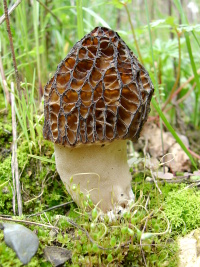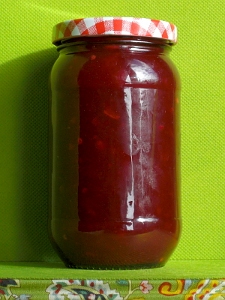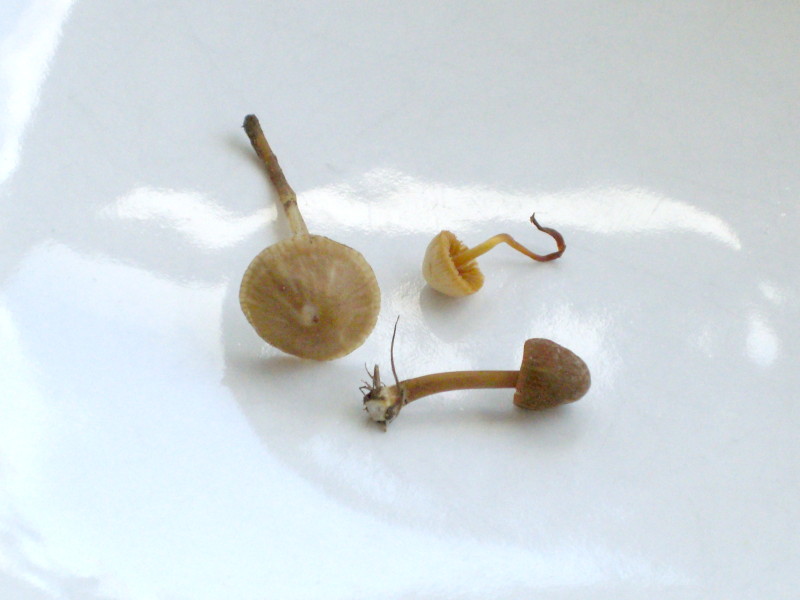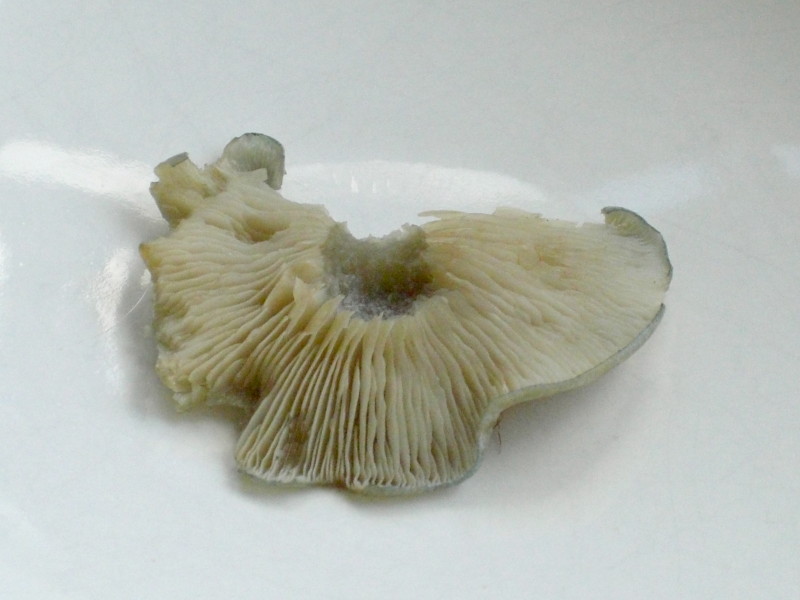Learning patience from wild food (and veg growing)
 As I said in my post about our fungi forage last weekend, that walk taught me to confidently identify about half a dozen wild mushroom species, and the wild food walk we did in the early summer taught me how to identify another half dozen things, mostly green leaves. These built on things I’d learnt how to identify myself and the obvious things that we all know (nettles, dandelions, blackberries etc). So after a couple of years of being interested in wild food, I can identify maybe 25 things with enough confidence to eat them. That’s not exactly that many when you consider the variety of stuff out there.
As I said in my post about our fungi forage last weekend, that walk taught me to confidently identify about half a dozen wild mushroom species, and the wild food walk we did in the early summer taught me how to identify another half dozen things, mostly green leaves. These built on things I’d learnt how to identify myself and the obvious things that we all know (nettles, dandelions, blackberries etc). So after a couple of years of being interested in wild food, I can identify maybe 25 things with enough confidence to eat them. That’s not exactly that many when you consider the variety of stuff out there.
When I want to learn a new craft or a new way to cook or bake something, I tend to grind it – a video game term for doing some repetitive task/quest over and over again in order to “level up” as quickly as possible so you can go onto more exciting things. When I was figuring out my (lazy) way to make slow rise no knead bread, I made it every other day for a fortnight. By the end of it, I was knocking out perfect, uniform loaves without much effort at all. By grinding it, I can quickly learn from my mistakes and don’t ever get stuck in a “it didn’t work last time, I don’t want to try again” slump.
But I can’t grind wild food. Nature won’t let me grind. It won’t let me focus on finding just one type of thing at any given time. I have to learn by its schedule and its randomness, an enforced slow learning curve.
Growing things in our garden is possible even worse. I’ve usually got a couple of months to collect and experiment with different wild plants before they go out of season, but I have, by and large, got one shot at growing things each year. If I miss the narrow sowing window or my seedlings die a few days after transplanting, that’s pretty much it – I have to wait a year to try again.
I always feel a bit sad when each wild food window closes – but I suspect it’s good for me to have these limitations in part of my life. It’ll teach me patience and there is nearly always something new to move onto finding or planting. I can continue reading about boletes & russulas and tomato seed varieties & manual pollination techniques over the winter – grinding the theory – but I have to wait until next year to continue the practical work.
After three decades of flitting from one thing to another fractionally more exciting thing, I think developing the skills of patience and sustained year-on-year learning is as important for me and my sustainable living as being able to tell the difference between a death cap and field mushroom. I just wish I’d started earlier ;)
Read MoreMushroom hunting at Ogden Water, Halifax
Yesterday John, Lily-dog and I went on a long awaited funghi forage, led by Jesper Launder and organised by Slow Food West Yorkshire.
We went on another wild food walk with Jesper & SlowFoodWY in May – mostly tasting different greens and crayfish – and as our interest in wild food and mushrooms has sky rocketed since then, we were very much looking forward to yesterday’s walk. Unfortunately some local rapscallions nearly caused us to miss it at the last minute – on leaving the house to get into the car, we found someone had nicked one of the wheels! We were grateful, again, that we have a cheap runaround car that we don’t really care about – and that they’d left all the nuts etc, so we could fit the spare and get to the walk just half an hour late.
We met the group in the woods just over the dam at Ogden Water. We’d not been to the reservoir before but will return again – it was misty so unearthily beautiful – and the woods a combination of broadleaf and conifer tree, making the mushroom picking extensive and varied. The group had already picked a few different types of mushroom but between us we found many, many more as the walk went on.
As with the considerably warmer and dryer wild food walk earlier in the year, Jesper enthusiastically identified every ‘shroom we took over to him, and told us how to use them or cook them, or whether to discard them unless we wanted hallucinations and painful death. There were too many different types to remember but I did get confirmations on some that I had been unsure about – and got to try eating some I’d seen & identified previously but not wanted to cook up for fear of that painful death stuff.
Some of the ones we got to eat and I’d happily pick & eat again:
- The Deceiver (Laccaria Laccata) – something I’ve seen before but not concretely identified, small and unsubstantial but good in a mixture
- Amethyst Deceiver (Laccaria Amethystea) – something we’d found before and identified, because nothing else is quite so purple
- Honey Fungus (Armillaria Mellea) – we found a full stump of these just near the end of the walk
- Grisettes (Amanita Vaginata) – something not included in my little pocket mushroom book so not something I’d really heard of before, but a decent size so well worth looking out for
- Wood Blewit (Lepista Nuda)
- The Blusher (Amanita Rubescens)
I also got to ask questions I’d been wanting to ask since I started identifying mushrooms such as “is there anything so poisonous that we shouldn’t pick it up?” (no, even licking your fingers after a death cap is probably ok) and “how much do you need to eat of the poisonous ones before the painful death thing?” (depends on the mushroom, some it’s a lot but death caps can sometimes kill after just half a cap so it’s well worth being careful).
I also got a book recommendation from Jesper – Mushrooms by Roger Philips – which will hopefully be a useful definitive guide in comparison to my existing not great ones. If nothing else, I find it very useful to cross-referencing potentially identifications (the more pictures the better).
All in all, despite the wheel-stealing-stress and the rain, it was a great day. We met some lovely people, learned a lot about funghi and found a fab new place to take Lily-dog. I’d highly recommend a walk with Jesper and will definitely be going on the next SlowFoodWY wild food walk.
(Apologies for the lack of pictures – I forgot my camera in all the where’s-the-wheel-gone hoohah. I’m hoping someone else will post some freely licensed pictures soon!)
Read MoreFrugal, growing and cooking link love
 I thought I’d share a little link love this afternoon – stuff I’ve seen on other frugal living, growing & cooking sites that I think you might enjoy too.
I thought I’d share a little link love this afternoon – stuff I’ve seen on other frugal living, growing & cooking sites that I think you might enjoy too.
- First up, Kate from Living the Frugal Live has revisited two seasonal posts from last year: her quick & easy leaf compost trick and collecting & storing acorns for chickens, to make her birds more sustainable.
- Speaking of foraging for food, Robin Eat Weeds has posted a Rosehip syrup recipe – I’m going to give this a go soon!
- Notes from the Frugal Trenches has some advice on stocking up on toiletries & household goods when they’re on sale – and where she finds the money to do that on a tight budget.
- Fiona on The Cottage Smallholder posted about a very odd but interesting veg, achocha – it tastes like cucumber when eaten raw, like green peppers when fried, and grows outside in the UK. I’ll definitely be trying that next year!
- And finally, speaking of other fun things to try, The Frugal Queen has been making soap – and has written a how-to for beginners, using common, easy to find ingredients.
Spotted – foxes and fungi
On our lunchtime dog walk today, the dog ran through the beck into the meadow – the steep hill of grassland a short way from our house – and stopped.
From the ridge at the top of the slope, two burnt orange foxes were staring back down at her – they looked between her and me, then ran off into the woodland between the meadow and our house. I wish I’d had time to take a picture – John’s yet to see any foxes around here and also, the contrast between their fur and the green grass was extraordinary.
Lily *needed* to thoroughly smell where the foxes had been so while she was busy with her nose, I looked for mushrooms. There were a number of different tiny bell cap type mushrooms around in the grass – I think the bigger one (which is about 10mm in diameter) is a brown bell cap (Conocybe Tenera), and the darker one is possibly a hay cap (Panaeolus Foenisecii). Not sure about the little one – possibly a baby brown bell cap?
I also spotted one of the biggest mushrooms I’ve seen around here – a Fly Agaric (Amanita Muscaria) about 20cm in diameter. It had been knocked off its stalk and the gills were damaged – either by the heavy-heavy rain from the other day or by foxes wanting a trip.
Finally, I saw a couple of interesting bluey-grey mushrooms on the edge between the woodland and grassland. This one is pretty badly damaged so I brought it home to identify it – and I’m pretty sure it’s an Aniseed Funnel Cap (Clitocybe Odora) — the smell is really quite distinctive.
Read MoreSpicy plum chutney recipe: plum & chilli jam
 With the last of the plums from the wild tree next to our house, I made a delicious spicy plum and chilli chutney.
With the last of the plums from the wild tree next to our house, I made a delicious spicy plum and chilli chutney.
The plums are slightly smaller than cultivated ones but highly flavoured – both sweet & tart at the same time. Yum!
My Spicy Marrow Chutney recipe uses flavours inspired by the Indian sub-continent but this spicy plum chutney uses flavours from further east than that.
It’s not a thick jelly-ish jam but is delicious spread thinly on a cracker and topped with a piece of tasty cheese. Mmm, cheese.
Spicy plum and chilli chutney recipe
Ingredients





